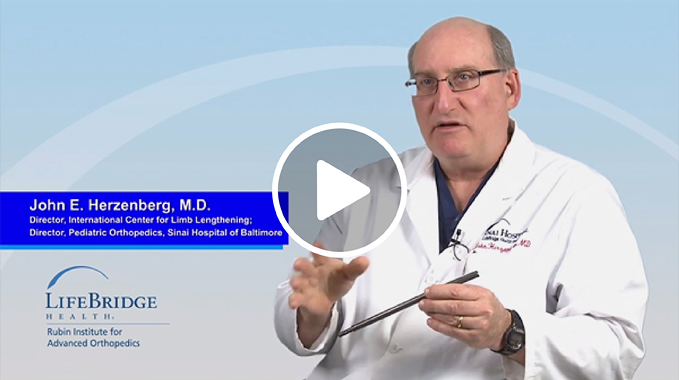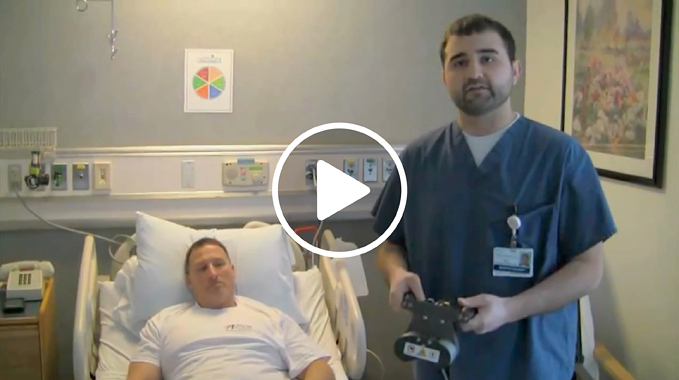Internal Fixation: Precice Nail
What is internal limb lengthening?
Internal limb lengthening is when the device used to lengthen the bone is inserted inside the bone. The lengthening device has a small magnetic motor inside it. When the motor is activated by an External Remote Controller (ERC), the device slowly lengthens, and this causes the bone to slowly lengthen.
Previously, the only way to lengthen a bone was to apply a metal scaffolding to the leg called an external fixator. External fixators are metal devices that are attached to the bones with special threaded pins or wires. These threaded pins or wires pass through the skin and muscles and are inserted into the bone. The majority of the lengthening device is outside of the body.
Please visit Limb Lengthening: The Process for general information about limb lengthening.
What is the Precice and how does it work?
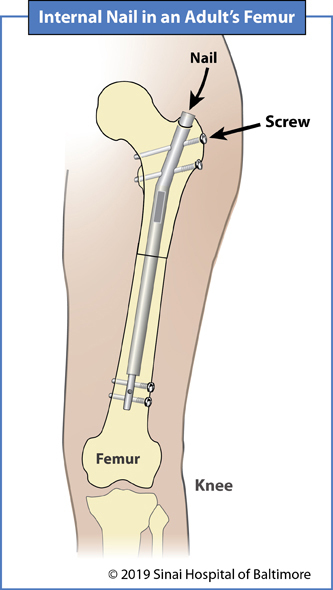 The Precice Lengthening System (NuVasive Specialized Orthopedics, San Diego, CA) consists of a telescoping metal rod, called a lengthening nail, with a magnetic motor inside of it. The nail is inserted through a small incision into the bone canal where the bone marrow is found.
The Precice Lengthening System (NuVasive Specialized Orthopedics, San Diego, CA) consists of a telescoping metal rod, called a lengthening nail, with a magnetic motor inside of it. The nail is inserted through a small incision into the bone canal where the bone marrow is found.
The patient is given a special device called an External Remote Controller (ERC) that is used to make the Precice nail slowly lengthen. The ERC has a magnet inside it that rotates. When the ERC is placed against the leg or arm and turned on, the movement of the magnet inside the ERC causes the magnetic motor inside the Precice to slowly lengthen. When the Precice lengthens, the bone also lengthens.
Will Precice lengthening hurt?
Precice lengthening with the ERC is so gradual that nearly all of our patients have told us that their leg does not hurt during the lengthening sessions.
What is our center’s experience with the Precice?
The original physician development team for the Precice nail consisted of Dr. Shawn Standard and Dr. John Herzenberg, both from the International Center for Limb Lengthening, and Dr. Stuart Green. These doctors worked with a company to produce this revolutionary new internal lengthening nail. Our doctors have been using the Precice system since 2012. The first model that was released was a modular design that was composed of two sections assembled at the time of surgery. The newer model is a single piece, which makes the nail much stronger.
We have found the Precice to be very effective in helping our patients. In the first 100 bones that we treated, 96% achieved the lengthening goal. In another study that we conducted, patients had lengthening with external fixation and then later had lengthening with the Precice. All the patients in the study preferred lengthening with the Precice over external fixation. They said that they had less pain, found physical therapy to be easier and liked the cosmetic appearance of the leg/arm better after treatment with Precice.
Since 2012, surgeons at the International Center for Limb Lengthening have implanted more than 710 Precice nails.
Will the Precice be a good option for every person who needs limb lengthening?
The Precice nail is offered in several lengths and diameters, but a person’s bone may still be too small for it. The diameter of the bone must be wide enough so that the Precice can fit inside the bone canal. The doctor will measure the diameter of the bone on an X-ray. The Precice is offered in three diameters: 8.5, 10.7 and 12.5 mm (0.33, 0.42, 0.50 inches).
The bone also needs to be long enough to fit the Precice. The shortest nail is 6.3 inches (160 mm) for the tibia and 6.7 inches (170 mm) for the femur. The doctor will measure the length of the bone on an X-ray to see if it is long enough to accommodate the Precice nail.
Another factor that must be considered is whether the ERC can be placed close enough to the Precice to make it lengthen. Soft-tissues (muscle, fat, skin) can be so thick that the ERC cannot be placed close enough to the Precice to activate lengthening. To see if the Precice will work for a patient, the doctor will measure the distance from the bone canal to the skin on an X-ray.
People are not good candidates for the Precice if they have a pacemaker or know that they will need an MRI scan in the next year. It is generally not recommended to have an MRI scan when a person has a Precice nail implanted. Therefore, we routinely recommend removal of the Precice about one year after surgery, provided that the lengthened bone is fully healed.
Can the Precice internal nail be used in children?
A Precice nail may be inserted in a child’s thigh bone (femur) starting at about age eight years. For the shin bone (tibia), it is preferable to wait until close to skeletal maturity (age 14 years in girls and age 16 years in boys).
How much will the Precice lengthen a bone?
The bone is lengthened in very small amounts each day until the lengthening goal is achieved. The maximum amount that can be lengthened depends on which model of the Precice is used. Different Precice models can lengthen the bone a total of 1.2 inches (30 mm), 2 inches (50 mm) or 3 inches (80 mm). For example, if the shortest Precice is the only one that fits in the bone, the patient may be limited to lengthening a total of 1.2 inches. In most cases, we can implant the models that allow 2 to 3 inches of length.
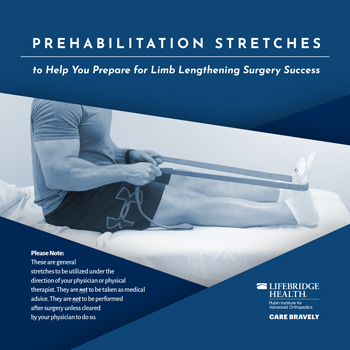 To help you prepare for limb lengthening surgery success, we have developed this brochure of prehabilitation stretches to perform in the months prior to surgery. This is not medical advice; please consult with your doctor before beginning any exercise regime.
To help you prepare for limb lengthening surgery success, we have developed this brochure of prehabilitation stretches to perform in the months prior to surgery. This is not medical advice; please consult with your doctor before beginning any exercise regime.What should be done to prepare for surgery?
Please visit our Before Surgery section for detailed information. During the visit with the doctor, ask for our guide to prepare for surgery. When planning for Precice surgery, you should also be aware of the following:
- Schedule any necessary MRI scans before surgery: The patient may not be allowed to have an MRI scan after the Precice is inserted. An MRI scan could de-magnetize the Precice nail, making it unable to lengthen.
- Learn about the precautions that should be taken with the ERC: If any family members have a cardiac pacemaker, the ERC will need to be kept away from them. The magnet in the ERC could affect the functioning of some pacemakers. The magnet in the ERC can also adversely affect items such as credit cards, magnetic room keys and cell phones.
- Prepare for the ERC to be loud: When the ERC is being used to lengthen, it is loud! Parents may want their children to become familiar with the sound before the surgery. Watch this video to hear what it sounds like when the ERC is being used to lengthen the Precice:
How is the Precice inserted during surgery?
The doctor needs to make space for the device to fit inside the bone. The outer part of a bone is made up of hard tissue, but the inside of a bone is made up softer marrow tissue. The doctor will use an orthopedic drill to create a canal in the marrow cavity in the center of the bone. This canal will be large enough for the Precice to fit inside it.
The way the Precice is inserted depends on the bone and the patient’s unique situation:
- For the femur (thigh bone), the device may be inserted in two different ways:
- One way that the Precice can be inserted is through the top of the femur that is closest to the hip. This insertion from the hip towards the knee is called antegrade insertion. The illustration below shows how the nail is inserted, the skin incisions that are made, and where the bone may be cut (osteotomy) and lengthened.
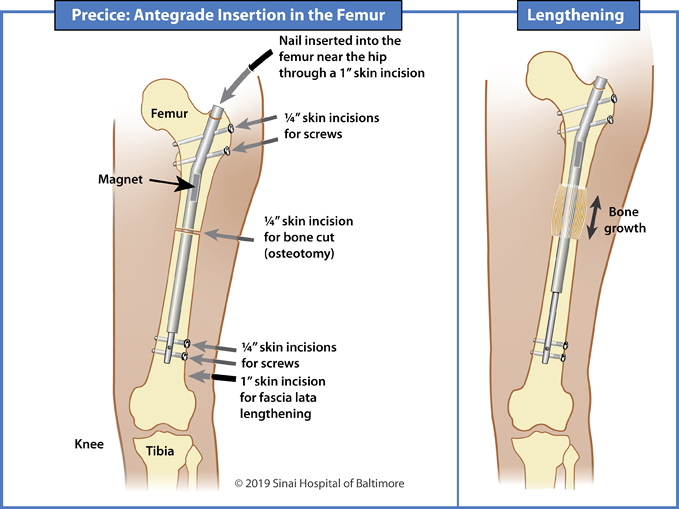
- Another way that the Precice can be inserted is through the bottom of the femur that is closest to the knee. This insertion from from the knee towards the hip is called retrograde insertion. The illustration below shows how the nail is inserted and the locations of the skin incisions and bone cut (osteotomy). Note that the location of the magnet in the femur when the Precice is inserted retrograde is different than when the Precice is inserted antegrade. The location of the magnet will affect where the patient places the ERC on the thigh. When the ERC is turned on and placed against the skin of the thigh, it causes the Precice to slowly lengthen.
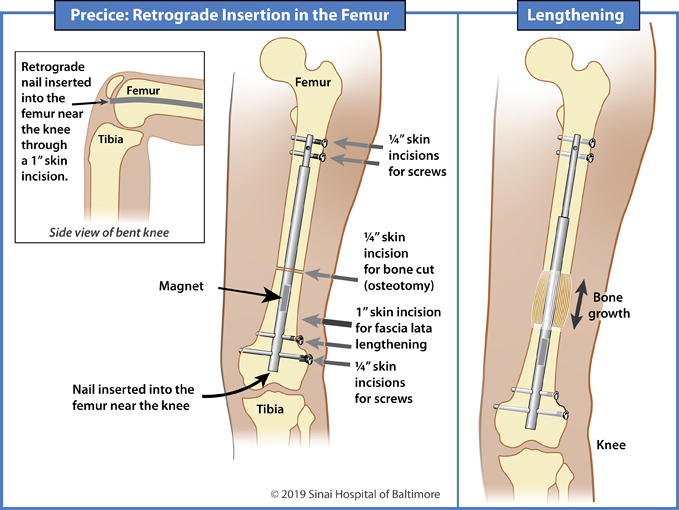
- For the tibia (shin bone), the device will almost always be inserted from the top of the tibia that is closest to the knee. The illustration below shows how the nail is inserted, the skin incisions that are made, and where the tibia and fibula may be cut (osteotomy) and lengthened.
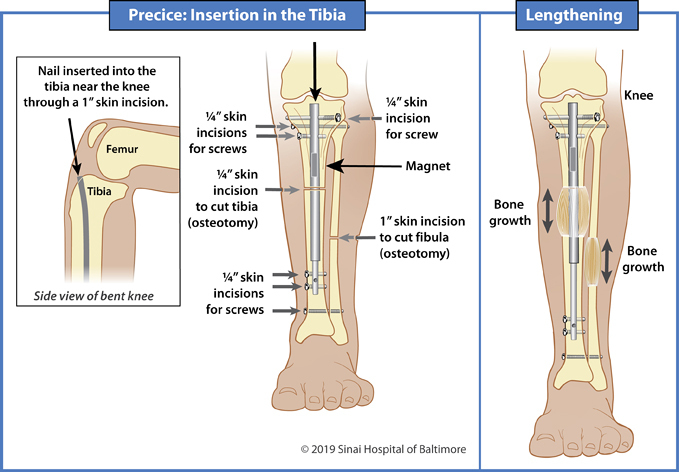
- For the humerus (upper arm bone), the device will be inserted through the top of the humerus that is closest to the shoulder (from the shoulder towards the elbow).
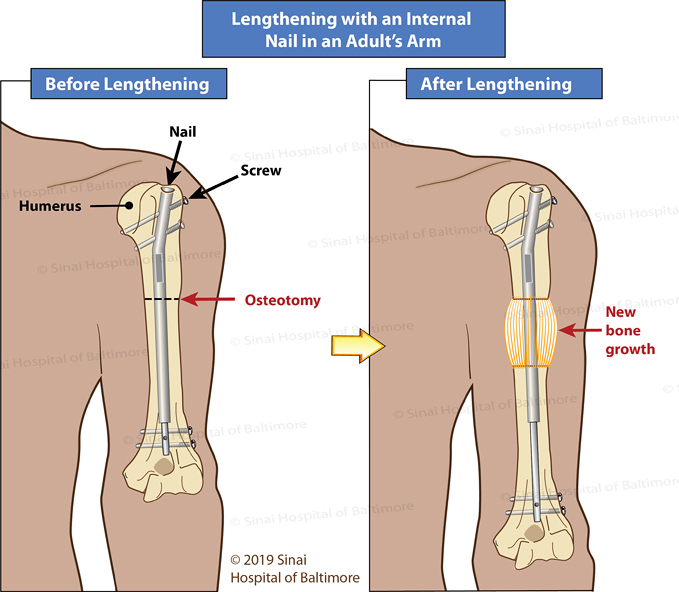
What happens after Precice insertion surgery?
After the Precice is inserted, the patient will stay in the hospital for 2 to 3 days. Our doctors prefer that the patient stays in the Baltimore area for at least the first 2 weeks after being discharged from the hospital. While using the ERC to lengthen the Precice (called the distraction phase), the patient will need to return to the ICLL for postoperative visits approximately every 10 to 14 days. After the distraction phase of treatment is completed, the consolidation phase starts where the bone solidifies and heals. The patient will need to return to the ICLL every month until the bone is healed.
Physical or occupational therapy is critical during the distraction and consolidation phases of treatment. During therapy, the muscles, tendons and ligaments are stretched in order to ensure that the arm or leg will have full movement after treatment. Patients will need physical therapy if they are lengthening the bones in the legs or occupational therapy if they are lengthening the humerus (upper arm bone). Our doctors may or may not allow this to be done in the patient’s home town, since some people need more specialized physical therapy, which is available at our center. The Rubin Institute’s physical therapy program for limb lengthening patients, led by Anil Bhave, PT, is the most experienced in the United States, if not the world. If patients require specialized physical therapy, they will need to stay in Baltimore for that period of time. In many cases, we also prescribe special braces/splints. These are generally made for the patient during the week after surgery.
The patient will be allowed only limited weight bearing on the leg with the Precice in it. The doctor will determine how much weight bearing is allowed on the leg based on each unique situation and the size and type of the Precice nail that is implanted. If both legs will be lengthened, the patient will need to be in a wheelchair.
Please talk to the surgeon if the patient needs to visit the dentist for routine cleaning or dental surgery during treatment. After the Precice is inserted, special antibiotics may be necessary in order to have dental work.
How is the ERC used to lengthen the bone?
When the ERC is turned on and placed against the skin of the leg or arm, it causes the Precice to slowly lengthen. When the Precice lengthens, the bone also lengthens. The ERC will stop when the patient has completed the correct amount of lengthening for that session.
When the arm or leg is swollen or has thick soft tissues, the doctor may instruct the patient to place the ERC against the skin and apply pressure to compress the soft tissues so that the ERC is closer to the Precice. Magnets work better when they are closer. Panels A and B below show MRI scans of a cross section of a thigh. The red arrow in panel A shows the distance between the ERC and the center of the bone (where the Precice would be inserted). In panel B, the skin and soft tissues are compressed so that the distance between the ERC and the Precice would be reduced (the red arrow in panel B is shorter than the red arrow in panel A).
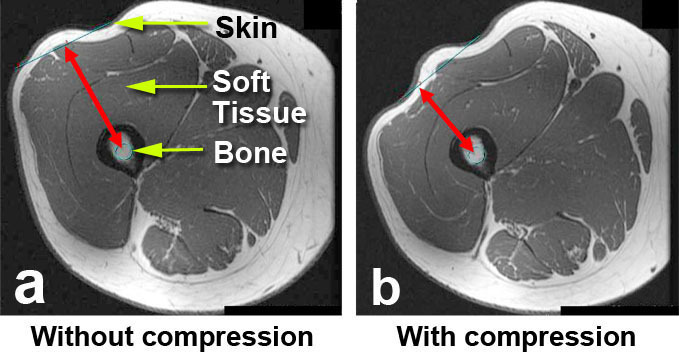
How often will the patient need to use the ERC?
The surgeon will prescribe how many separate lengthening sessions need to be done each day and the amount of lengthening for each session. Typically, patients are asked to lengthen the bone 0.75 to 1 mm each day (0.03 to 0.04 inches; there are 25 mm in 1 inch).
For example, a patient could be asked to lengthen 0.25 mm during four different sessions throughout the day, which would result in a total of 1 mm of lengthening each day. Each session with the ERC would takes about 2 minutes to lengthen the bone 0.25 mm. Four sessions would take a total of 8 minutes per day.
When can the Precice be removed?
Typically, the Precice is removed approximately 1 year after insertion. The removal procedure is an outpatient surgery, which means that the patient does not need to stay in the hospital overnight after the removal. The lengthened bone should be fully and circumferentially healed before considering removal of the Precice.
